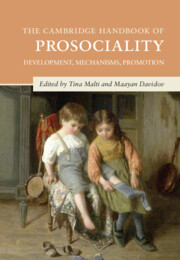Book contents
- The Cambridge Handbook of Prosociality
- Cambridge Handbooks in Psychology
- The Cambridge Handbook of Prosociality
- Copyright page
- Dedication
- Contents
- Figures
- Contributors
- Part I Development of Prosociality
- Part II Antecedents and Mechanisms of Prosociality
- Part III Development of Prosociality in Context
- Part IV Applications
- 26 Fostering Prosociality in the Family Context
- 27 Prosociality and Civic Engagement
- 28 Prosocial Behavior, Positive Youth Development, and Character Virtues
- 29 Relational Practices of Care to Nurture Prosociality and Advance Policy
- 30 Toward a New Era of Prosociality Research
- Afterword
- Index
- References
29 - Relational Practices of Care to Nurture Prosociality and Advance Policy
from Part IV - Applications
Published online by Cambridge University Press: 25 May 2023
- The Cambridge Handbook of Prosociality
- Cambridge Handbooks in Psychology
- The Cambridge Handbook of Prosociality
- Copyright page
- Dedication
- Contents
- Figures
- Contributors
- Part I Development of Prosociality
- Part II Antecedents and Mechanisms of Prosociality
- Part III Development of Prosociality in Context
- Part IV Applications
- 26 Fostering Prosociality in the Family Context
- 27 Prosociality and Civic Engagement
- 28 Prosocial Behavior, Positive Youth Development, and Character Virtues
- 29 Relational Practices of Care to Nurture Prosociality and Advance Policy
- 30 Toward a New Era of Prosociality Research
- Afterword
- Index
- References
Summary
This chapter focuses on relational practices of care to nurture prosociality in children and adolescents. We begin by introducing care as an ethical stance toward another that requires attention and commitment to another, as well as sensitivity to the developmental needs and uniqueness of every child. We then outline the practices of relational care, and how they matter for efforts aimed at nurturing children and adolescents’ prosocial orientations. It is argued how recognition of and careful attention to children and adolescents and their ethical development can move humanity forward, and how true commitment to others and an ethical self can contribute to the flourishing of all children. We present examples of nurturing care, including community-based and organizational initiatives as well as existing research-based psychological programs, and we discuss implications for policy. We conclude by outlining next steps for a future agenda of transforming nurturing care for all children and adolescents.
- Type
- Chapter
- Information
- The Cambridge Handbook of ProsocialityDevelopment, Mechanisms, Promotion, pp. 577 - 599Publisher: Cambridge University PressPrint publication year: 2023



